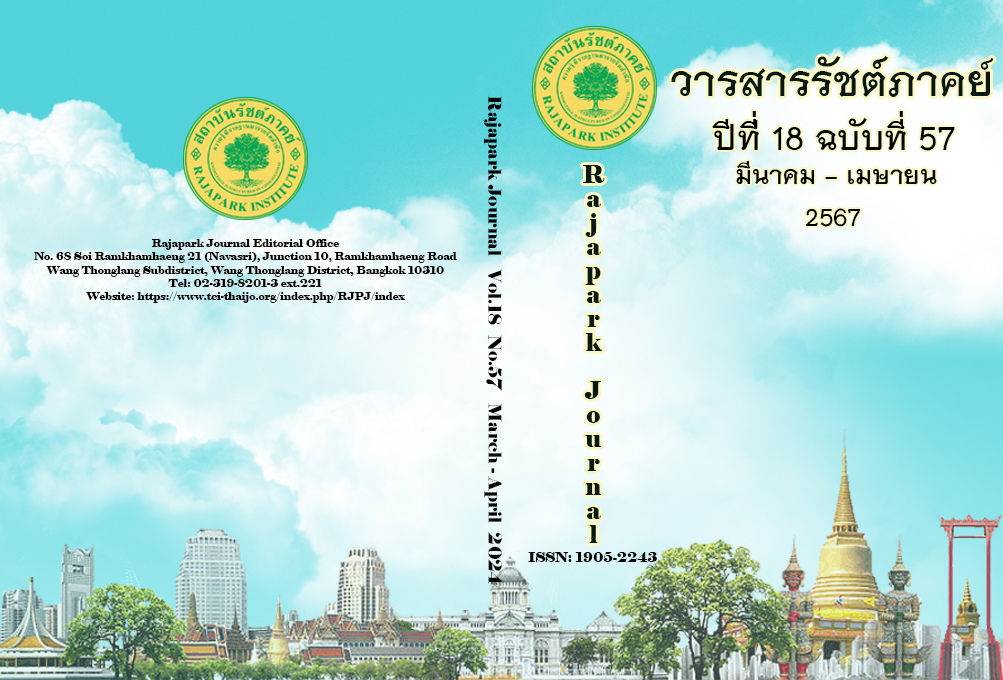The Effect of Economic Integration on the Sugar Export of Thailand
Main Article Content
Abstract
This research aimed to study the structure of sugar production and sugar exports in Thailand and the impact of economic integration on Thailand's sugar exports to trading partners with the highest value of Thai sugar exports, which include Indonesia, Cambodia, Myanmar, and Vietnam. The data used in the study is panel data collected over the past 20 years, from 2001 to 2020. Independent variables are the gross domestic product (GDP) of trading partners, the imported sugar prices of trading partners (IMPRI), and the free trade agreement (FTA). The dependent variable is the volume of Thai sugar exports to trading partners (EX). The total data includes 80 observations. This study applied the unit root test and panel data analysis using a fixed effect regression model. The results of the study found that factors affecting the volume of Thai sugar exports are the gross domestic product of the trading partner country (GDP), which will have a positive impact when the trading partner country's income increases. As a result, the volume of Thai sugar exports has also increased. And the price of imported sugar from trading partners (IMPRI) has a negative impact on the volume of Thai sugar exports. It was also found that the economic cooperation agreement had a negative impact on the volume of Thai sugar exports. In addition, by comparing the relationship of variables using the fixed effect method, it was found that the variables of Indonesia, Cambodia, Myanmar, and Vietnam are related in the same direction.
Article Details

This work is licensed under a Creative Commons Attribution-NonCommercial-NoDerivatives 4.0 International License.
Views and opinions appearing in the Journal it is the responsibility of the author of the article, and does not constitute the view and responsibility of the editorial team.
References
Armstrong, S. (2015). The economic impact of the Australia-United States free trade agreement. Australian Journal of International Affairs, 69(5), 513-537.
Akhmadi, H. (2017). Assessment the impact of Asean Free Trade Area (AFTA) on Exports of Indonesian Agricultural Commodity. Journal of Agribusiness and Rural Development Research, 3(1), 9-14.
Butsayawit, S. (2009). Economics of Integration. Ramkhamhaeng University.
Chaisongkram, R. (2014). The Effect of The ASEAN – China Free Trade Area On Consumer Surplus of Thailand and China[Master’s Thesis, Kasetsart University].
Dlamini, S.G., Edriss, A.K., Phiri, A.R., & Masuku, M.B. (2016). Determinants of Swaziland’s Sugar Export: A Gravity Model Approach. International Journal of Economics and Finance, 8(10), 71. DOI:10.5539/ijef.v8n10p71
Department of Trade Negotiations. (2021, December 20). Trade Information of Agricultural Products: Sugarcane and Sugar Report. Department of Trade Negotiations. https://dtn.go.th/th/tradeinfo/อ้อยและน้ำตาลทราย?cate=5d303ed3ef41400db11a9a60
Department of Foreign Trade. (2021, November 13). Trade benefits Report. Department of Foreign Trade. https://www.dft.go.th/th-th/dft-service-data-privilege
Fuller, K., & Kennedy, P.L. (2019). A determination of factors influencing sugar trade. International Journal of Food and Agricultural Economics, 7(1), 19-29.
Global Trade Information Services, INC. (2023, July 19). Global trade atlas. Global Trade Information Services, INC. https://connect.ihsmarkit.com/gta/data-extracts/
Homkhachon, K. (2020). International Economics (3th ed.). Ramkhamhaeng University.
International Sugar Organization. (2023, July 19). Sugar Yearbook 2022. ISO. https://www.isosugar.org/publication/296/iso-sugar-yearbook-2022
Jirawatcharawong, K. (2013). Factors Affecting The Quantity of Thai Sugar Exports[Master’s Thesis, Ramkhamhaeng University].
Mingmaninakhin, W. (2010). Principles of Microeconomics (19th ed.). Thammasat University.
Niyommak, K. (2014). Factors Influencing The Export of Thai Sugar To Indonesia[Master’s Thesis, Ramkhamhaeng University].
Office of The Cane and Sugar Board. (2022, March 8). Sugar for Domestic Consumption Report. Office of The Cane and Sugar Board. http://www.sugarzone.in.th/sale/TIMAT463.PDF
Office of The Cane and Sugar Board. (2023, July 19). Sugarcane Growing Situation Report. Office of The Cane and Sugar Board. https://www.ocsb.go.th/report_area_yield/
Office of The Cane and Sugar Board. (2023, July 19). Sugar Production by Sugar Factories Report. Office of The Cane and Sugar Board. https://www.ocsb.go.th/report_can_sugar_production_2565-66/report_can_sugar_production_2565-66/รายงานประจำวัน/
Phatthanuwat, P. (2019). A Comparison of International Trade After The Free Trade Agreement In The South Asian Association For Regional Cooperation (SAARC)[Master’s Thesis, Ramkhamhaeng University].
Thapphan, Y. (2014). International Trade of Economics: Theory and Policy (3th ed.). Thammasat University.
The Food and Agriculture Organization. (2023, February 19). Crops and livestock products database. FAO. https://www.fao.org/faostat/en/#data/QCL
The World Bank. (2022). GDP of Indonesia, Cambodia, Myanmar and Vietnam. http://api.worldbank.org
Tubpia, P. (2018). Factors Influencing the Export of Thai Agricultural Products to ASEAN Countries[Master’s Thesis, Ramkhamhaeng University].


